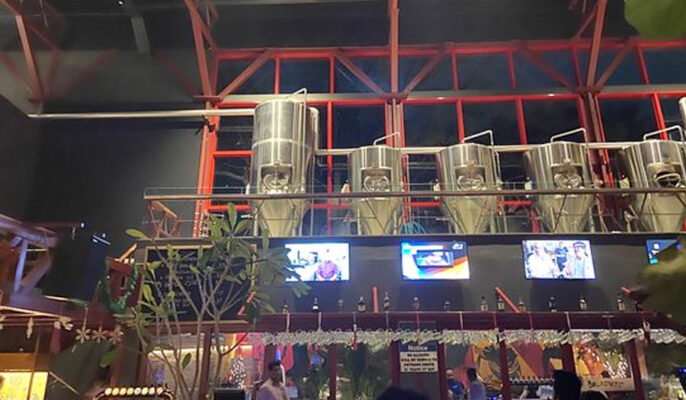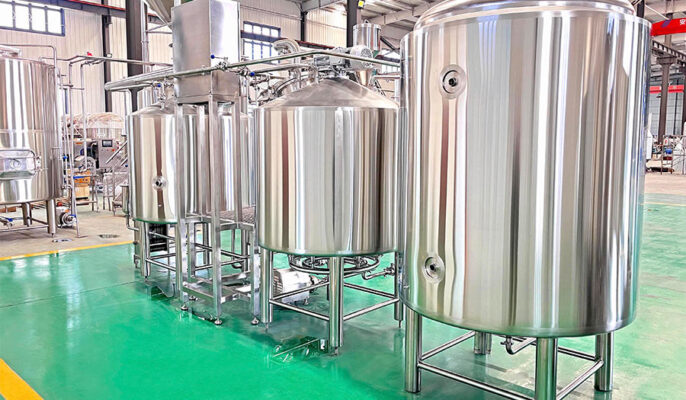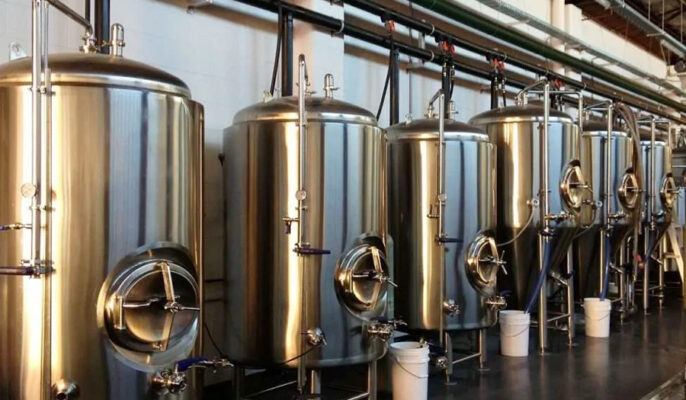Microbirrificio e birrificio artigianale hanno molte cose in comune, ma sono anche molto diversi. Nell'attuale mercato della birra, ricco di scelte diverse, i microbirrifici e i birrifici artigianali, in quanto due forme di produzione uniche, stanno gradualmente conquistando il favore dei consumatori. Sebbene i due tipi di birra presentino molte somiglianze sotto alcuni aspetti, differiscono in modo significativo per quanto riguarda la scala di produzione, le caratteristiche del processo e il posizionamento sul mercato. Il microbirrificio è noto per il suo modello di produzione su piccola scala e localizzato e per lo stretto legame con la comunità. Allo stesso tempo, il birrificio artigianale ha ricevuto un'ampia attenzione per la sua innovazione nel gusto della birra e per la ricerca dell'alta qualità.
Definizione e dimensioni di microbirrificio e birrificio artigianale
Che cos'è un microbirrificio?
Un microbirrificio è un impianto di produzione di birra di dimensioni ridotte e con una produzione limitata, di solito intorno ai 1.500-3.000 litri all'anno. Queste strutture tendono a concentrarsi sulla fornitura di birre speciali nel mercato locale, enfatizzando la flessibilità del processo di produzione e il legame con la comunità. Devono inoltre vendere 75% o più della loro birra in una sede esterna, anche se alcuni microbirrifici hanno una piccola sala di degustazione o un bar per i consumatori in visita. I microbirrifici completano le vendite in uno dei tre modi seguenti:
- Sistema a tre livelli: I produttori vendono la birra ai grossisti, i grossisti vendono la birra ai dettaglianti e i dettaglianti vendono la birra ai consumatori.
- Sistema a due livelli: I produttori di birra agiscono come grossisti e vendono la birra ai dettaglianti, che la vendono ai consumatori.
- Vendite dirette: I produttori di birra vendono direttamente ai consumatori attraverso l'asporto o la vendita in loco nei bar o nei ristoranti.

Che cos'è un birrificio artigianale?
Un birrificio artigianale è un impianto di produzione di birra caratterizzato da piccoli lotti, alta qualità e innovazione. Di solito utilizzano metodi di produzione tradizionali e ingredienti di alta qualità e si impegnano a creare birre uniche e saporite.
- Innovazione di processo: I birrifici artigianali spesso esplorano nuovi metodi di produzione e combinazioni di materie prime per ottenere un sapore e un gusto unici della birra. Questo include l'uso di diversi tipi di malto, luppolo e lievito, e persino l'aggiunta di ingredienti non tradizionali come frutta o spezie.
- Produzione di piccoli lotti: Anche se la scala dei birrifici artigianali può variare, di solito si concentrano sulla produzione di piccoli lotti. Questo metodo di produzione consente ai produttori di concentrarsi maggiormente sulla qualità e sul sapore di ciascun lotto.
- Ingredienti di alta qualità: I birrifici artigianali scelgono solitamente ingredienti di alta qualità, come malto, luppolo e lievito. La scelta di questi ingredienti ha un impatto importante sul sapore e sul gusto della birra.
- Personalizzazione e diversificazione: I birrifici artigianali spesso offrono una varietà di gusti diversi di birra, che vanno dagli stili tradizionali ai sapori innovativi e sperimentali. I consumatori possono scegliere diversi tipi di birra in base alle loro preferenze di gusto.
- Storia del marchio e legame con la comunità: I birrifici artigianali di solito si concentrano sulla creazione di storie di marca e sull'interazione con i consumatori. Possono stabilire connessioni con la comunità attraverso attività come festival della birra e degustazioni per migliorare l'affinità e l'identità del marchio.
- Posizionamento sul mercato: I birrifici artigianali non si limitano a servire il mercato locale, ma possono anche promuovere i loro prodotti in un mercato più ampio attraverso i canali di distribuzione, compresi i mercati nazionali o internazionali.

Differenze tra microbirrificio e birrificio artigianale produzione di birra processi
Processo di produzione di birra per microbirrifici
- Attrezzature e processi semplificati: I microbirrifici di solito utilizzano attrezzature e processi di produzione relativamente semplici. Anche se queste attrezzature sono in grado di produrre birra di alta qualità, la loro tecnologia e i loro processi non sono così complessi o avanzati come quelli dei birrifici artigianali.
- Caratteristiche locali: I microbirrifici spesso adattano le loro ricette di birra in base alle preferenze di gusto dei consumatori locali e alla domanda del mercato. Questo metodo di produzione localizzato può portare a una diversità di sapori della birra, ma questa diversità di solito ruota intorno alle tradizioni locali e ai sapori popolari.
- Flessibilità di produzione: Grazie alle loro dimensioni ridotte, i microbirrifici hanno una maggiore flessibilità nella produzione. Possono modificare rapidamente i piani di produzione e le ricette per rispondere ai cambiamenti del mercato o al feedback dei consumatori.
- Produzione di piccoli lotti: I microbirrifici si concentrano solitamente sulla produzione di piccoli lotti, che consentono ai produttori di controllare finemente ogni lotto, mantenendo così la consistenza e la freschezza della birra.
Processo di produzione della birra artigianale
- Tecnologia e attrezzature complesse: I birrifici artigianali di solito utilizzano attrezzature più avanzate e complesse, tra cui sistemi per il controllo preciso della temperatura, della pressione e delle condizioni di fermentazione. Queste tecnologie possono aiutare i produttori a creare sapori di birra più delicati e unici.
- Innovazione e sperimentazione: I birrifici artigianali danno grande importanza all'innovazione e alla sperimentazione dei processi. Spesso provano nuovi metodi di produzione, nuove combinazioni di materie prime e additivi dal sapore unico come frutta, spezie o miele per creare birre dalla personalità unica.
- Materie prime di alta qualità: I birrifici artigianali utilizzano in genere malto, luppolo e lievito di alta qualità e sono molto attenti alla selezione delle materie prime. Queste materie prime di alta qualità svolgono un ruolo fondamentale nell'esaltare il sapore e il gusto della birra.
- Enfasi su sapore e complessità: I birrifici artigianali si concentrano sulla complessità del sapore e del gusto della birra. I birrai tendono a mettere a punto ogni fase della produzione per garantire che ogni birra possa mostrare le sue caratteristiche gustative uniche.
- Marketing e costruzione del marchio: I birrifici artigianali non si concentrano solo sui processi di produzione, ma attribuiscono grande importanza anche alle storie del marchio e al marketing. Le loro birre hanno spesso storie e caratteristiche dettagliate, che diventano parte integrante dei loro prodotti.
Caratteristiche dei microbirrifici e dei birrifici artigianali
Caratteristiche del microbirrificio
- Produzione su piccola scala: La produzione annuale si aggira solitamente tra i 1.500 e i 3.000 litri e la scala è piccola.
- Localizzazione: Servono principalmente il mercato locale, producendo birre caratteristiche e dal sapore locale.
- Attrezzature semplificate: Utilizzando attrezzature di produzione semplici ed efficienti, il processo è relativamente elementare.
- Flessibilità: Capacità di adattare rapidamente i piani di produzione e le ricette per rispondere ai cambiamenti del mercato e alla domanda dei consumatori.
- Collegamento con la comunità: Stretto legame con la comunità locale, spesso aumentando l'interazione attraverso attività di degustazione e festival locali.
- Personalizzazione: Focus sull'unicità e la personalizzazione dei prodotti, spesso in combinazione con la cultura e le tradizioni locali.
Caratteristiche del birrificio artigianale
- Materie prime di alta qualità: Utilizzare malto, luppolo e lievito di alta qualità e prestare attenzione alla selezione e alla lavorazione delle materie prime.
- Innovazione di processo: Utilizzare metodi di produzione tradizionali e innovativi e spesso sperimentare per creare sapori unici.
- Produzione in piccoli lotti: La scala di produzione è di solito piccola e consente un controllo fine di ogni lotto.
- Diversificazione del gusto: Fornire una ricca varietà di sapori di birra, concentrandosi sulla complessità e sulla stratificazione del gusto.
- Storia del marchio: Attribuiscono importanza alla costruzione del marchio, spesso attirando i consumatori raccontando storie del marchio e partecipando alle attività della comunità.
- Posizionamento sul mercato: Oltre al mercato locale, attraverso la rete di distribuzione è possibile entrare in un mercato più ampio, che comprende i mercati nazionali e internazionali.

L'esperienza dei consumatori di microbirrifici e birrifici artigianali è differente
Nei microbirrifici, i consumatori hanno spesso l'opportunità di partecipare a degustazioni in loco e tour della fabbrica, e questa interattività è una caratteristica importante. La comunicazione diretta tra consumatori e produttori può migliorare la comprensione e l'interesse per il prodotto.
I birrifici artigianali possono offrire esperienze di degustazione più ricche e attività educative, incoraggiando i consumatori a esplorare diversi sapori di birra e a partecipare alla condivisione delle storie del marchio. Questa esperienza non si limita al sito, ma può essere ampliata anche attraverso attività e degustazioni online.
FAQ
Quali sono le principali differenze tra microbirrifici e birrifici artigianali?
I microbirrifici sono di dimensioni più ridotte, di solito con una produzione annua compresa tra 1.500 e 3.000 litri, e servono principalmente il mercato locale. I birrifici artigianali si concentrano sull'innovazione dei processi e sull'alta qualità e possono essere di piccole o grandi dimensioni, ma di solito enfatizzano la complessità e l'unicità del sapore.
Qual è la differenza di posizionamento sul mercato tra microbirrifici e birrifici artigianali?
I microbirrifici si rivolgono principalmente al mercato locale, concentrandosi sulle caratteristiche locali e sui legami con la comunità. I birrifici artigianali non si limitano a servire il mercato locale, ma si espandono anche a un mercato più ampio attraverso le reti di distribuzione, compresi i mercati nazionali e internazionali.
Quali sono le differenze nella selezione delle materie prime tra microbirrifici e birrifici artigianali?
I microbirrifici possono utilizzare materie prime a basso costo ed enfatizzare le caratteristiche locali della produzione. I birrifici artigianali utilizzano solitamente materie prime di alta qualità e sono più attenti alla selezione e alla lavorazione, perseguendo l'unicità e la complessità dei sapori della birra.




